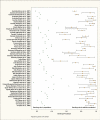An international systematic review of smoking prevalence in addiction treatment
- PMID: 26392127
- PMCID: PMC4990064
- DOI: 10.1111/add.13099
An international systematic review of smoking prevalence in addiction treatment
Abstract
Aims: Smoking prevalence is higher among people enrolled in addiction treatment compared with the general population, and very high rates of smoking are associated with opiate drug use and receipt of opiate replacement therapy (ORT). We assessed whether these findings are observed internationally.
Methods: PubMed, PsycINFO and the Alcohol and Alcohol Problems Science Database were searched for papers reporting smoking prevalence among addiction treatment samples, published in English, from 1987 to 2013. Search terms included tobacco use, cessation and substance use disorders using and/or Boolean connectors. For 4549 papers identified, abstracts were reviewed by multiple raters; 239 abstracts met inclusion criteria and these full papers were reviewed for exclusion. Fifty-four studies, collectively comprising 37,364 participants, were included. For each paper we extracted country, author, year, sample size and gender, treatment modality, primary drug treated and smoking prevalence.
Results: The random-effect pooled estimate of smoking across people in addiction treatment was 84% [confidence interval (CI) = 79, 88%], while the pooled estimate of smoking prevalence across matched population samples was 31% (CI = 29, 33%). The difference in the pooled estimates was 52% (CI = 48%, 57%, P < .0001). Smoking rates were higher in programs treating opiate use compared with alcohol use [odds ratio (OR) = 2.52, CI = 2.00, 3.17], and higher in ORT compared to out-patient programs (OR = 1.42, CI = 1.19, 1.68).
Conclusions: Smoking rates among people in addiction treatment are more than double those of people with similar demographic characteristics. Smoking rates are also higher in people being treated for opiate dependence compared with people being treated for alcohol use disorder.
Keywords: Addiction; co-substance use; global health; priority/special populations; smoking; surveillance and monitoring; tobacco.
© 2015 Society for the Study of Addiction.
Figures
Comment in
-
Commentary on Guydish et al. (2016): The continuing deadly threat of tobacco use in addiction treatment.Addiction. 2016 Feb;111(2):231-2. doi: 10.1111/add.13229. Addiction. 2016. PMID: 26767337 No abstract available.
References
-
- World Health Organization . WHO global report: mortality attributable to tobacco. WHO; Geneva: 2012.
-
- World Health Organization . WHO report on the global tobacco epidemic. WHO; Geneva: 2013.
-
- Giovino GA, Mirza SA, Samet JM, Gupta PC, Jarvis MJ, Bhala N, et al. Tobacco use in 3 billion individuals from 16 countries: an analysis of nationally representative cross-sectional household surveys. The Lancet. 2012;380(9842):668–79. - PubMed
-
- Martínez C, Martínez-Sánchez JM, Robinson G, Bethke C, Fernández E. Protection from secondhand smoke in countries belonging to the WHO European Region: an assessment of legislation. Tob Control. 2014;23(5):403–11. - PubMed
Publication types
MeSH terms
Grants and funding
LinkOut - more resources
Full Text Sources
Other Literature Sources
Medical
Miscellaneous



